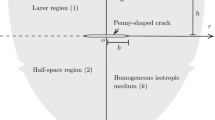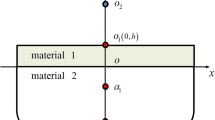Abstract
In this study, the dual-phase-lag (DPL) heat conduction model is applied to study the non-Fourier heat transfer in a thermal barrier coating (TBC) structure subjected to heat flux on the exterior of the coating. An efficient numerical scheme involving the hybrid application of the Laplace transform and control volume methods in conjunction with hyperbolic shape functions is used to solve the hyperbolic heat conduction equations in the linearized form of DPL model. The transformed nodal temperatures are inverted to the physical quantities using numerical inversion of the Laplace transform. Parametric studies of properties of the substrate and the coating on the temperature distributions in the TBC are performed. A comparison between the present study and other work in the literature using the thermal wave model is also made. The results also show that the phase lag of heat flux tends to induce thermal waves with sharp wave fronts separating heated and unheated zones in the structure, while the phase lag of temperature gradient results in non-Fourier diffusion-like conduction and smooths the sharp wave fronts by promoting conduction into the medium.















Similar content being viewed by others
Abbreviations
- c :
-
Specific heat (J kg−1 K−1)
- k :
-
Thermal conductivity (W m−1 K−1)
- \(L_{1}\) :
-
Domain extent for the substrate (m)
- \(L_{2}\) :
-
Domain extent for the TBC (m)
- l :
-
Dimensionless distance between two neighboring nodes
- m :
-
Node number at the interface
- Q :
-
Dimensionless heat flux defined in Eq. (14)
- q :
-
Heat flux (W m−2)
- R :
-
Ratio of thermophysical properties between the substrate and the TBC
- r :
-
Position vector (m)
- s :
-
Laplace transform parameter
- T :
-
Temperature (K)
- \(T_{c}\) :
-
Isothermal boundary condition at the substrate (K)
- \(T_{R}\) :
-
Reference temperature (K)
- \(T_{0}\) :
-
Initial temperature (K)
- t :
-
Time (s)
- u :
-
Step function
- x :
-
x-Coordinate (m)
- \(\alpha\) :
-
Thermal diffusivity (m2 s−1)
- \(\eta\) :
-
Dimensionless distance defined in Eq. (14)
- \(\theta\) :
-
Dimensionless temperature defined in Eq. (14)
- \(\lambda\) :
-
Parameter defined in Eq. (26)
- \(\rho\) :
-
Density (kg m−3)
- \(\xi\) :
-
Dimensionless time defined in Eq. (14)
- \(\xi_{d}\) :
-
Dimensionless time of exposure of heat flux on TBC
- \(\tau_{q}\) :
-
Phase lag of the heat flux (s)
- \(\tau_{T}\) :
-
Phase lag of the temperature gradient (s)
- i :
-
Node index
- j :
-
Domain index
References
Akwaboa S, Mensah P, Diwan R (2010) Effect of thermal radiation on air plasma spray (APS) coated gas turbine blade. In: Proceedings of ASME turbo expo congress and exposition, Glasgow, UK, 14–18 June 2010
Frankel JI, Vick B, Ozisik MN (1987) General formulation and analysis of hyperbolic heat conduction in composite media. Int J Heat Mass Transf 30:1293–1305
Cattaneo C (1958) A form of heat conduction which eliminates the paradox of instantaneous propagation. Comp Rend 247:431–433
Vernotte P (1961) Some possible complications in the phenomena of thermal conduction. Comp Rend 252:2190–2191
Ozisik MN, Tzou DY (1994) On the wave theory in heat conduction. ASME J Heat Transf 116:526–535
Tzou DY (1997) Macro- to micro-scale heat transfer: the lagging behavior. Taylor and Francis, Washington, DC
Bayazitoglu Y, Peterson GP (1992) Fundamental issues in hyperbolic heat conduction. ASME HTD, p 227
Tzou DY, Ozisik MN, Chiffelle RJ (1994) The lattice temperature in the microscopic two-step model. ASME J Heat Transf 116:1034–1038
Taitel Y (1972) On the parabolic, hyperbolic and discrete formulation of the heat conduction equation. Int J Heat Mass Transf 15:369–371
Koerner C, Bergmann HW (1998) Physical defects of the hyperbolic heat conduction equation. Appl Phys A: Mater Sci Process 67:397–401
Godoy S, García-Colín LS (1997) Nonvalidity of the telegrapher’s diffusion equation in two and three dimensions for crystalline solids. Phys Rev E 55:2127–2131
Tzou DY (1995) A unified field approach for heat conduction from macro- to micro-scales. ASME J Heat Transf 117:8–16
Tzou DY (1995) Experimental support for the lagging response in heat propagation. J Thermophys Heat Transf 9:686–693
Tzou DY, Chiu KS (2001) Temperature-dependent thermal lagging in ultrafast laser heating. Int J Heat Mass Transf 44:1725–1734
Ramadan K, Al-Nimr MA (2009) Thermal wave reflection and transmission in a multilayer slab with imperfect contact using the dual-phase-lag model. Heat Transf Eng 30:677–687
Ordóñez-Miranda J, Alvarado-Gil JJ (2010) Exact solution of the dual-phase-lag heat conduction model for a one-dimensional system excited with a periodic heat source. Mech Res Commun 37:276–281
Liu KC, Chen HT (2010) Investigation for the dual phase lag behavior of bio-heat transfer. Int J Therm Sci 49:1138–1146
Lee HL, Chen WL, Chang WJ, Wei EJ, Yang YC (2013) Analysis of dual-phase-lag heat conduction in short-pulse laser heating of metals with a hybrid method. Appl Therm Eng 52:275–283
Akwaboa S, Mensah P, Dag Y (2013) Study of heat transfer in a thermal barrier coatings system using the dual phase lag model based on mean value finite volume method. In: Proceedings of the ASME 2013 international mechanical engineering congress and exposition, IMECE2013-66060
Liu KC, Wang JC (2014) Analysis of thermal damage to laser irradiated tissue based on the dual-phase-lag model. Int J Heat Mass Transf 70:621–628
Akwaboa S, Mensah P, Beyazouglu E, Diwan R (2012) Thermal modeling and analysis of a thermal barrier coating structure using non-fourier heat conduction. ASME J Heat Transf 134:111301-1–111301-12
Akbarzadeh AH, Chen ZT (2014) Dual phase lag heat conduction in functionally graded hollow spheres. Int J Appl Mech 6:1450002-1–1450002-27
Liu KC, Cheng PJ (2006) Numerical analysis for dual-phase-lag heat conduction in layered films. Numer Heat Transf A 49:589–606
Yang YC, Lee HL, Hsu JC, Chu SS (2008) Thermal stresses in multilayer gun barrel with interlayer thermal contact resistance. J Therm Stress 31:624–637
Chen HT, Lin JY (1993) Numerical analysis for hyperbolic heat conduction. Int J Heat Mass Transf 36:2891–2898
Acknowledgments
This work was supported by the Ministry of Science and Technology, Taiwan, Republic of China, under the Grant Number MOST 103-2221-E-168-004.
Author information
Authors and Affiliations
Corresponding author
Additional information
Technical Editor: Francis HR Franca.
Rights and permissions
About this article
Cite this article
Yang, YC., Chen, WL., Yeh, TS. et al. Numerical study of dual-phase-lag heat conduction in a thermal barrier coating with a hybrid method. J Braz. Soc. Mech. Sci. Eng. 38, 287–296 (2016). https://doi.org/10.1007/s40430-015-0412-7
Received:
Accepted:
Published:
Issue Date:
DOI: https://doi.org/10.1007/s40430-015-0412-7




